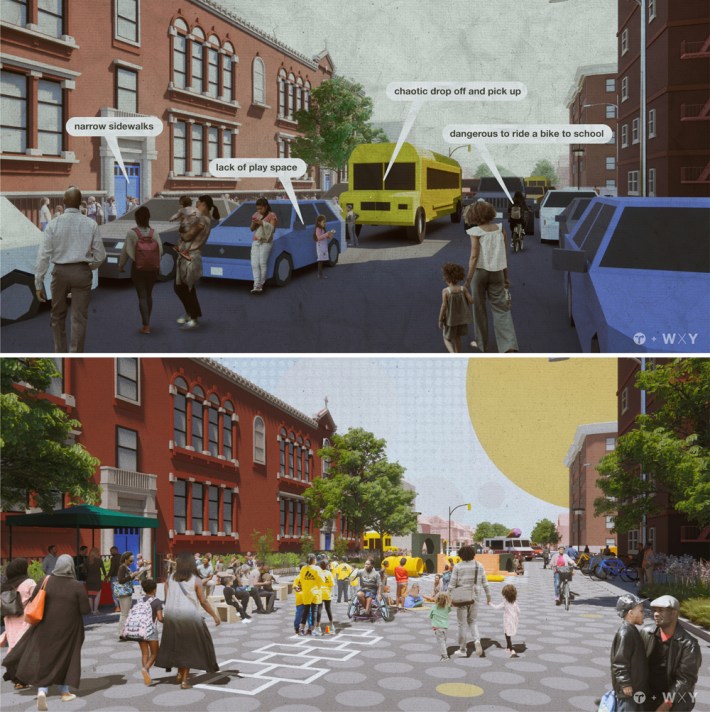Around the time I discovered Streetsblog Chicago, I found the Bike Portland blog as well. I’ve been reading the site more regularly over the past two years and I recently came across a Bike Portland article about “Cheap and easy ways to reduce transportation emissions.” Within the article was the idea to ban driving on streets next to schools. I couldn’t be more on board with this. In the United States, traffic crashes are a leading cause of death and thousands of children are injured in collisions as well. It feels like a no-brainer to target areas around schools with intense traffic calming or banning through car-traffic.
In my neighborhood of Rogers Park, I frequently use Bosworth and Greenview avenues as alternatives to the Glenwood Greenway, which I find narrow and uncomfortable on some stretched and I’m saddened by the lack of traffic calming next to Joyce Kilmer Elementary School and Sullivan High School. As I bike south to Edgewater, I pass by a number of schools that could benefit from traffic calming on the nearby streets. I’d love to see the Chicago Department of Transportation work to install traffic calming and create play streets near Chicago Public Schools.
With CDOT currently going through a strategic realignment (though I’ve heard nothing else about CDOT’s strategic planning efforts since the department announced this last fall), I’d like to see the agency reemerge with a greater focus on the mobility needs and desires of children and substantive Vision Zero work. Maybe it’s my inner child speaking to me more as I approach another birthday. I’ve been thinking a lot about the absence of free children and play in general on our streets. We’re missing out on a lot by not incorporating the needs of children and the need for play (for people of all ages and abilities) in city planning and development. Some aldermen and city agencies have created youth councils which can be a great way to lift up the voices of young people. CDOT would do well to develop relationships with youth groups and young people in general. I know our streets would look very different if their design was influenced by the needs of more people who don't drive.
CDOT Commissioner Gia Biagi has said some encouraging things, subtly hinting that streets can be more than just places to move and store vehicles. When the city announced its Al Fresco program, expanding car-free public space to support outdoor dining and/or community gatherings, Biagi had this to say, "Chicago has never needed its streets more, and we’ve never needed more out of our streets... As the crises mounted last year, we supported neighborhoods with streets open for healthy activity [i.e. Slow Streets], community connection, and for safe, outdoor dining. As we emerge from the shadow of the pandemic, we must continue to put our streets in the service of what people and small businesses need in their neighborhoods to keep everybody safe and moving while keeping us all together.”
I am absolutely inspired by the Barcelona Superblocks rollout which has transformed many neighborhood blocks into sites of social interaction, play, relaxation, and so much more.
Our streets can and should be more than just places for drivers to pass through or cars to be stored. One of New York City’s sustainable transportation advocacy groups, Transportation Alternatives, launched "25 x 25", a campaign encouraging NYC to dedicate 25 percent of the space currently used for moving and parking cars to other purposes such as protected bike lanes, more open streets, and car-free spaces in front of schools. I would love to see similar demands materialize in Chicago. Here's an image from the 25x 25 campaign

Transportation Alternatives described the benefits of school streets thusly:
Shutting the majority of the streets outside schools to car traffic with permanent retractable bollards will calm local traffic, reduce traffic noise filtering into classrooms, make walking and biking to school safer, and allow for a safe and controlled drop-off and pick-up zones and the installation of bike parking. A full street closure to cars will also make room for a multipurpose educational and recreational space with active play spaces, teaching gardens, outdoor lunchrooms, and outdoor classrooms, as well as greening elements like bioswales, trees, and benches for waiting parents. It will also significantly reduce childrens’ exposure to air pollution and asthma incidence.
Here are some more sources of inspiration for brainstorming how we can create safe streets that enable safe play:
- National Association for Transportation Officials' Streets for Kids Initiative
- CityLab article: "We Need More Public Space for Teen Girls" (but I’d argue we need more public space for everyone)
- "Soft City: Building Density in Everyday Life" by David Sim
- "Once Upon a Playground: A Celebration of Classic American Playgrounds, 1920-1975" by Brenda Biondo.




